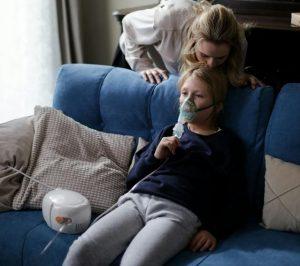Often at times, parents and teachers alike can face the dilemma of deciding whether or not to allow a child to go to school or to keep them at home when the child is feeling unwell.
You don’t want them to miss out on their education while being absent from school, but you also don’t want them to spread germs to others or worsen their condition.
That’s why this guide will provide some tips and examples to help you make the right decision as a parent or teacher.
Important Health Guidance to Consider
 Firstly, you should always follow the government guidelines for schools and nurseries about managing specific infectious diseases at GOV.UK. GOV.UK strive to provide the most up-to-date information on any outbreaks, as well as offer the most recent recommendations to deal with illnesses.
Firstly, you should always follow the government guidelines for schools and nurseries about managing specific infectious diseases at GOV.UK. GOV.UK strive to provide the most up-to-date information on any outbreaks, as well as offer the most recent recommendations to deal with illnesses.
These web pages explain when children should be kept off school and when they shouldn’t.
For example, the government website will make recommendations such as: ‘Children with diarrhoea or vomiting should stay away from school until they have not been sick or had diarrhoea for at least 2 days (48 hours).’
As well ‘Children with chickenpox should stay at home until all the spots have crusted over, which is usually about 5 days after the spots first appeared.’
Some Health Indicators that can help
You should use your judgement and common sense based on your child’s symptoms and behaviour.
A good rule of thumb is to ask yourself if the child is properly awake, alert, and has a normal appetite, playfulness, and chattiness. If yes, they are probably going to cope at school even if they have a minor cough, cold or sore throat. These are common ailments that help build up their immune system.
However, if the child has a high temperature, severe pain, drowsiness, no appetite or is unusually quiet, it’s best to keep them at home and monitor their condition. You know the child best and what is normal for them.
You can also check out some common myths and misconceptions about common child illnesses here:
Source: Interactive Asset can be found with further information on Medical tracker’s blog post
Common Child Illness and what to do.
Here are some examples of ways a child may be ill and how to act as a teacher or parent:
1. Sore throat
 A sore throat can have many causes, from being caused by various bacteria, allergens, dry air, irritation, or even infections. If a child has a sore throat but no other symptoms, in most cases they can go to school so long as they feel well enough. However, if the child has a sore throat along with one or more of the following other symptoms such as a fever, swollen glands, headache, or rash, they may have a more serious illness called strep throat, which is a bacterial infection that requires antibiotics to clear up. In instances like these, keep or send the child home and consult a GP as soon as possible.
A sore throat can have many causes, from being caused by various bacteria, allergens, dry air, irritation, or even infections. If a child has a sore throat but no other symptoms, in most cases they can go to school so long as they feel well enough. However, if the child has a sore throat along with one or more of the following other symptoms such as a fever, swollen glands, headache, or rash, they may have a more serious illness called strep throat, which is a bacterial infection that requires antibiotics to clear up. In instances like these, keep or send the child home and consult a GP as soon as possible.
2. Ear infection
An ear infection can cause pain, fever, and both short and long-term hearing problems in a child. If a child has an ear infection and a high temperature or severe earache, keep them off school until they’re feeling better, or their high temperature goes away. They may need treatment from a GP, often with antibiotics.
3. Stomach-ache
A stomach-ache can be caused by various reasons, such as indigestion, constipation, food poisoning or appendicitis. If a child is only suffering from a minor stomach-ache and no other symptoms, they can go to school as long as they feel well enough. However, if the child has a severe stomach-ache or a stomach-ache along with vomiting, diarrhoea, fever, or blood in their stool, they may have a more serious condition that needs medical attention. Keep them at home and get a GP to check if the symptoms persist or worsen.
4. Rash
A rash can be caused by various factors, such as allergies, eczema, heat, or infection. Some rashes are harmless and do not require treatment, while others are contagious and need medication. If a child has a rash but no other symptoms, they can go to school as long as the rash does not bother them or spread to others. But if a child has a rash along with fever, itching, swelling or blisters, they may have an infectious disease such as chickenpox, measles, or impetigo. They should stay at home and see a GP for diagnosis and treatment.
Parents should also be advised to inform the school about a diagnosis that would require further action within the school, and schools should maintain a record of illnesses to detect if an outbreak within the school occurs.
In summary, deciding whether a child is too sick for school depends on several factors: the type and severity of their symptoms; their overall well-being; the risk of infecting others; and the government guidelines for specific diseases. When in doubt, check with the school nurse or a GP for advice.
Author Profile

- Editor in Chief
- Blogger and Educator by Passion | Senior Online Media & PR Strategist at ClickDo Ltd. | Contributor to many Education, Business & Lifestyle Blogs in the United Kingdom & Germany | Summer Course Student at the London School of Journalism and Course Instructor at the SeekaHost University.
Latest entries
 Directory PostsOctober 29, 20257 Not-To-Miss UK Education Conferences in 2026
Directory PostsOctober 29, 20257 Not-To-Miss UK Education Conferences in 2026 Directory PostsOctober 16, 2025The 12 Best Online Tutoring Platforms in the UK
Directory PostsOctober 16, 2025The 12 Best Online Tutoring Platforms in the UK Directory PostsOctober 6, 2025Top 12 London Private Schools – Best Independent Schools Nearby
Directory PostsOctober 6, 2025Top 12 London Private Schools – Best Independent Schools Nearby careerSeptember 10, 20258 Top Online Future Career Courses To Know
careerSeptember 10, 20258 Top Online Future Career Courses To Know





